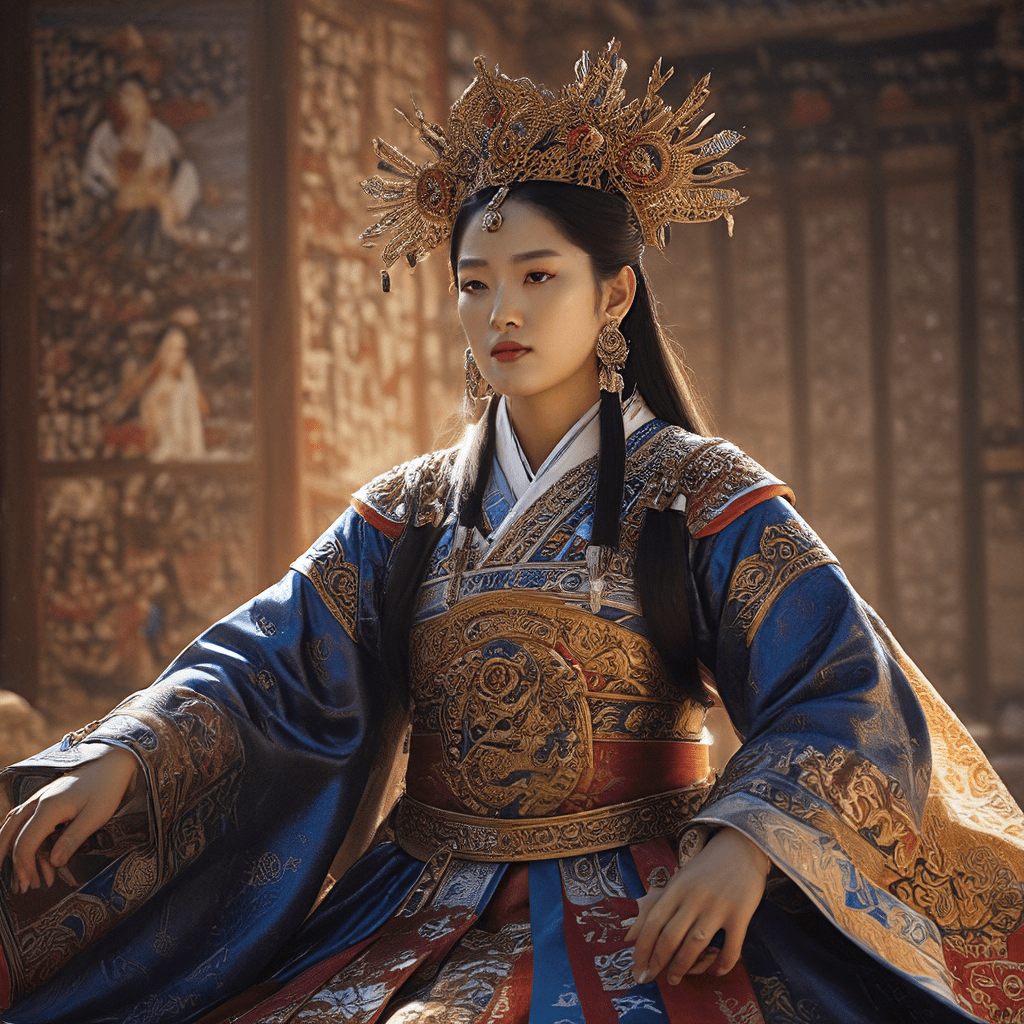The Legendary Origins of Queen Seondeok
Queen Seondeok, the first female ruler of the Unified Silla Kingdom in Korea, is a figure steeped in legend and historical significance. Her story is one that has captivated the imaginations of Koreans for centuries, weaving together elements of myth, prophecy, and political acumen. While much of her life remains shrouded in mystery, her reign is celebrated as a golden age in Silla history, a testament to her visionary leadership and the strength of the Silla kingdom.
The tale of Seondeok's birth is intertwined with a prophecy that foretold the rise of a female ruler who would bring peace and prosperity to Silla. According to legend, a radiant golden crow landed on the royal palace, and a mysterious light radiated from the queen's chambers. This event was interpreted as a sign that a powerful and benevolent female ruler would soon be born. The prophecy, passed down through generations, ultimately pointed to Seondeok, born as the daughter of King Jinpyeong and Lady Maya.
Seondeok: The First Female Ruler of Silla
The Silla Kingdom was established in 57 BC and unified Korea in the 7th century AD. For centuries, the throne passed from father to son, with no precedent for a woman to rule. This tradition was challenged when Seondeok, a princess of exceptional intelligence and strategic mind, ascended the throne in 632 AD. Seondeok's reign marked a significant turning point in Silla history, breaking the male-dominated lineage and setting a powerful precedent for female leadership in Korean society.
It is important to remember that the Silla kingdom had a strong emphasis on Confucianism, a philosophy that promoted patriarchal social structures and viewed women as subservient to men. Seondeok's ascension to the throne was a bold act of defiance against these traditional norms, a testament to her own charisma and strength of character. Her reign was marked by a willingness to challenge the status quo, to break the barriers of tradition and pave the way for future generations of women to rise to positions of power.
Seondeok’s Reign: Achievements and Challenges
Queen Seondeok's reign, though short-lived, was marked by a period of great achievement. She oversaw a flourishing period of economic and cultural prosperity, strengthened Silla's diplomatic ties with neighboring kingdoms, and established a strong foundation for the Silla Kingdom's future dominance.
Her reign saw the construction of numerous Buddhist temples, a testament to the flourishing of Buddhist culture in Silla during her reign. These temples were not just places of worship, but centers of learning and artistic expression, contributing to the flourishing of Silla culture.
However, Seondeok's reign was not without its challenges. Silla was a powerful kingdom, but it was constantly facing threats from neighboring states. Seondeok, a shrewd strategist and a gifted diplomat, skillfully navigated her kingdom through these challenges, maintaining peace and stability while ensuring the continued prosperity of Silla.
The Prophecy of the Golden Crow
The legend of the Golden Crow is deeply intertwined with Seondeok's life and reign. The prophecy, which predicted the rise of a female ruler who would bring prosperity to Silla, was widely believed in Silla society. It attributed extraordinary qualities to the future queen, qualities that Seondeok seemed to embody.
The legend of the Golden Crow is a fascinating example of how mythology and folklore can be used to legitimize power and reinforce social norms. In this case, the prophecy served to legitimize Seondeok's reign and to challenge traditional notions of female leadership.
The prophecy also served to inspire the Silla people. Seondeok's reign, marked by success and stability, was seen as a fulfillment of the prophecy, further reinforcing its authenticity and solidifying Seondeok's position as a divinely ordained ruler.
The Mystery of Seondeok’s Birth
The details of Seondeok's birth remain shrouded in mystery. While some historical accounts mention her birth as the daughter of King Jinpyeong and Lady Maya, the exact circumstances surrounding her birth are unclear. The legend surrounding her birth, linked to a prophecy of a golden crow, further adds an air of mystery and wonder to her story.
The lack of detailed information about Seondeok's birth may be attributed to several factors. Firstly, historical records from Silla during this period are not complete and frequently lack specific details about individuals. Secondly, the legend surrounding Seondeok's birth may have been deliberately embellished over time, adding to the mystique surrounding her life.
Despite the lack of concrete details, it is clear that Seondeok's birth was considered a significant event, imbued with great symbolism. The prophecy of the Golden Crow and the circumstances surrounding her birth contributed to the perception of Seondeok as a divinely appointed ruler, a figure destined to lead Silla to greatness.
Seondeok’s Visionary Leadership
Queen Seondeok, known for her intelligence and strategic brilliance, was not just a figurehead but a true leader. Her reign saw the Silla kingdom flourish, a testament to her visionary leadership. She understood the importance of diplomacy and built strong relationships with neighboring kingdoms, ensuring peace and stability for Silla.
Seondeok was also a patron of the arts and culture. Her reign saw the construction of magnificent Buddhist temples, showcasing both the kingdom's wealth and its commitment to Buddhist values. These temples also became centers of learning and artistic expression, further enriching Silla culture.
One notable example of Seondeok’s foresight was her decision to build the "Wolseong Fortress", a massive fortification that protected Silla from any potential invaders. This was a strategic move that ensured the kingdom's safety and stability, a testament to her understanding of the importance of military preparedness.
Seondeok's success was not just about strength and strategy, but also about her ability to inspire and guide her people. She is remembered as a just and wise ruler, someone who genuinely cared for the well-being of her subjects. Her reign is seen as a golden age in Silla history, a period of prosperity and peace, a direct result of her astute and compassionate leadership.
Seondeok’s Legacy: A Symbol of Female Power
Queen Seondeok's reign was a pivotal moment in Korean history. She shattered the traditional male-dominated power structure, proving that women could not only rule, but rule effectively. Her legacy is an inspiration to generations of Korean women, a symbol of their potential to achieve greatness in any field.
The story of Seondeok is woven into the very fabric of Korean culture, inspiring countless works of art, literature, and drama. Her image transcends time, serving as a constant reminder of the strength and resilience of women in Korean society.
Her legacy is not merely about her accomplishments as a ruler, but also about her impact on the perception of women in Korean society. She challenged the Confucian norms that had long relegated women to a secondary role, paving the way for a more inclusive and equitable society.
The story of Queen Seondeok is a powerful testament to the potential of female leadership, a story that continues to inspire and empower women in Korea and beyond.
Theories on Seondeok’s Real Character
While Seondeok is celebrated as a wise and benevolent ruler, historical accounts offer glimpses into a more complex personality. Some historians suggest she was a shrewd strategist, a pragmatic leader who understood the need to maintain power and stability in a turbulent world. Others highlight her compassionate side, pointing to her efforts to promote cultural development and ensure the well-being of her people.
These diverse interpretations of Seondeok's character reflect the complex nature of her historical legacy. She was not just a ruler, but a woman of her time, navigating the challenges of a complex and changing world. Her reign was a testament to her intelligence, her courage, and her ability to adapt to circumstances.
While some may argue that the legend surrounding Seondeok has obscured her real character, it is important to remember that legends are often born from real events and real people. Seondeok's story, steeped in folklore and historical accounts, provides a glimpse into the complexity of her personality and the challenges she faced as a woman ruling in a patriarchal society.
Seondeok in Korean Literature and Art
Queen Seondeok's story has inspired countless works of Korean literature and art. From historical novels to dramatic plays, her life and reign have been interpreted and re-imagined by generations of Korean artists and writers.
One notable example is the novel "The Tale of Seondeok," which narrates her life and reign, highlighting her wisdom, strategic brilliance, and her unwavering commitment to her people. The historical drama “Queen Seondeok,” a popular television series, further popularized Seondeok’s story, bringing her life and legacy to a wider audience.
These works of art not only celebrate Seondeok's achievements but also offer insight into the evolving perception of her character and her reign. They demonstrate the enduring impact of her story on Korean culture and the continued fascination with her legacy.
Modern Interpretations of Queen Seondeok
In modern Korea, Queen Seondeok remains an iconic figure, a symbol of female power and resilience. Her story continues to resonate with audiences, inspiring new interpretations and representations. Contemporary artists explore her character and her reign in diverse artistic mediums, from paintings and sculptures to modern dance and theater performances.
These modern interpretations reflect the evolving cultural landscape of Korea, with contemporary artists drawing inspiration from Seondeok's story to explore themes of gender equality, social justice, and the importance of strong female leadership.
Seondeok's reign, marked by both challenges and achievements, continues to provide a lens through which modern-day Koreans examine their own society and their aspirations for the future. Her legacy serves as a reminder of the power of human potential, the importance of breaking down social barriers, and the importance of celebrating female achievements in all spheres of society.
FAQ
Q: What was Queen Seondeok's biggest achievement?
A: Queen Seondeok's reign saw the Silla kingdom flourish, a testament to her visionary leadership. She built strong diplomatic relationships with neighboring kingdoms, ensuring peace and stability for Silla. Additionally, her patronage of the arts and culture contributed to the flourishing of Silla culture and also strengthened the kingdom's influence.
Q: What challenges did Queen Seondeok face as the first female ruler of Silla?
A: As the first female ruler of Silla, Seondeok faced a number of challenges, including:
Tradition: Silla society was strongly patriarchal, with Confucian teachings dictating that women should be subservient to men. Her rule challenged these traditional norms.
Skepticism: Some members of the court and the public may have been skeptical of her ability to rule. They may have questioned her legitimacy and her ability to lead effectively.
External Threats: Silla was a powerful kingdom, but it faced threats from neighboring states. Seondeok had to navigate these challenges while ensuring the kingdom's security and prosperity.
Q: What is the significance of the Golden Crow prophecy in Queen Seondeok's story?
A: The prophecy of the Golden Crow played a significant role in legitimizing Seondeok's reign and reinforcing her image as a divinely appointed ruler. The legend surrounding her birth, linked to the prophecy, attributed extraordinary qualities to her, further solidifying her position as a powerful and benevolent leader.
Q: How is Queen Seondeok remembered in Korean culture today?
A: Queen Seondeok remains an iconic figure in Korean culture, symbolizing female power and resilience. Her story continues to inspire new interpretations and representations, particularly in contemporary art and literature. She is celebrated as a wise and capable leader, a figure who broke down social barriers and paved the way for future generations of women to achieve greatness.



